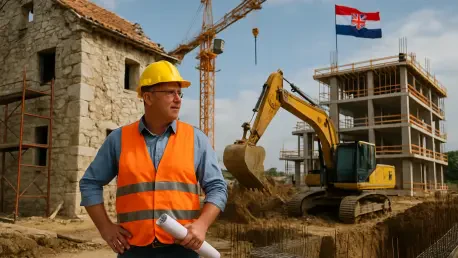In a significant move to reshape the construction landscape, Croatia has unveiled a draft Construction Act aimed at streamlining building processes while clamping down on illegal practices. This legislative proposal, introduced by the Ministry of Physical Planning, Construction and State Assets, seeks to address longstanding inefficiencies in the sector, foster investment, and improve housing accessibility across the nation. With a focus on simplifying procedures for smaller projects and enhancing regulatory oversight, the Act promises to modernize an industry often bogged down by bureaucracy. It also prioritizes safety and quality, ensuring that development aligns with national goals for sustainable growth. As public consultation unfolds, this initiative sparks curiosity about how these reforms will balance speed with accountability, potentially setting a new standard for construction practices in the region.
Streamlining Building Procedures for Greater Accessibility
The proposed legislation places a strong emphasis on simplifying the construction process, particularly for smaller-scale projects such as family homes. Unlike larger residential developments, these builds will no longer require exhaustive main designs, with a conceptual design deemed sufficient to move forward. This change slashes the volume of paperwork and accelerates approval timelines significantly. Additionally, supervision for such projects will zero in on structural safety, while secondary documentation like detailed execution plans takes a backseat. By reducing the number of parties involved in approvals, the Act aims to eliminate unnecessary bureaucratic hurdles, making it easier for individuals and small investors to initiate projects. This approach not only cuts costs but also encourages more people to engage in lawful construction, addressing housing shortages in a practical manner. The Ministry views these adjustments as a way to democratize access to building opportunities without compromising essential safety standards.
Beyond simplifying requirements, the Act introduces procedural efficiencies that promise to reshape how projects are managed from start to finish. A key reform is the reduction of intermediaries in the approval chain, allowing designers to directly access necessary conditions and connection requirements via a digital platform. This eliminates delays caused by excessive back-and-forth between public bodies, a common frustration in the past. Moreover, projects deemed of national importance—such as those tied to government, education, or healthcare—will receive prioritized processing under the new framework. This prioritization underscores their strategic value to Croatia’s development goals, ensuring critical infrastructure isn’t stalled by red tape. By focusing on speed and clarity, these changes aim to create a more responsive system that can adapt to the needs of a growing economy while maintaining rigorous oversight to prevent shortcuts that could jeopardize quality.
Combating Illegal Construction with Stricter Oversight
One of the standout features of the draft Act is its firm stance against illegal construction, a persistent challenge in Croatia’s building sector. To curb unauthorized activities, the legislation mandates an on-site inspection prior to permit issuance, ensuring compliance is verified from the very beginning. Should construction commence without proper authorization, investors will face substantial penalties, including a special fee, while the building inspectorate will be notified to enforce further action. This proactive approach seeks to deter violations by making the consequences immediate and costly. The goal is to foster a culture of accountability within the industry, where adherence to regulations becomes the norm rather than the exception. Such measures are expected to reduce the prevalence of unlawful builds, which often pose safety risks and undermine urban planning efforts.
In addition to preemptive inspections, the Act strengthens regulatory mechanisms to maintain compliance throughout the construction lifecycle. A notable requirement is the ongoing involvement of project designers, who must provide expert support until a use permit is granted. This ensures consistent oversight and addresses potential issues before they escalate. Furthermore, the introduction of a Building Maintenance Plan, to be submitted alongside use permit applications, emphasizes long-term care for structures and equipment. This forward-thinking provision aims to extend the lifespan of buildings and prevent deterioration due to neglect. By combining strict initial checks with sustained monitoring, the legislation tackles illegal construction from multiple angles, aiming to create a safer and more orderly built environment that aligns with national standards and public expectations.
Embracing Digital Innovation for Modern Construction
Digital transformation lies at the heart of the proposed reforms, with the gradual integration of Building Information Modeling (BIM) technology set to revolutionize the sector. BIM enables collaboration through intelligent 3D models that connect planning, design, construction, and maintenance phases, enhancing efficiency and reducing errors. Its full rollout, planned in stages over the coming years, signals a long-term commitment to modernizing how projects are executed. Alongside this, enhancements to the existing electronic permitting platform will further streamline administrative tasks, cutting down on delays that have historically plagued the industry. These technological advancements are poised to position Croatia as a leader in adopting innovative tools for construction, potentially attracting foreign investment by showcasing a commitment to cutting-edge practices.
Complementing the push for digital tools, the Act also focuses on integrating technology into everyday regulatory processes to improve transparency. The shift toward electronic systems for obtaining permits and conditions eliminates the need for cumbersome manual interactions with multiple agencies. This not only saves time but also creates a clearer audit trail, making it easier to track compliance and address discrepancies. As these systems evolve, they are expected to set a benchmark for how technology can simplify complex industries without sacrificing accountability. The emphasis on digital solutions reflects a broader vision of aligning Croatia’s construction sector with global standards, ensuring that both local stakeholders and international partners can operate within a predictable and efficient framework. This modernization effort is a critical step toward sustaining growth in a competitive market.
Reflecting on Reforms and Future Pathways
Looking back, the draft Construction Act represented a pivotal moment for Croatia’s construction industry, as it tackled deep-rooted inefficiencies and illegal practices with a bold, multifaceted strategy. The reforms, which spanned simplified procedures, stricter compliance measures, and digital innovation, laid a foundation for a more accessible and accountable sector. As public consultation concluded, the input from stakeholders proved instrumental in refining the legislation, ensuring it addressed real-world challenges. Moving forward, the focus should shift to effective implementation, with robust training for industry professionals on new digital tools and regulatory requirements. Continuous monitoring will be essential to gauge the impact of these changes on housing availability and investment trends. Additionally, periodic reviews of the Act’s provisions could help adapt to emerging needs, ensuring that Croatia’s built environment evolves sustainably while maintaining high standards of safety and quality.









